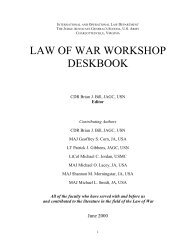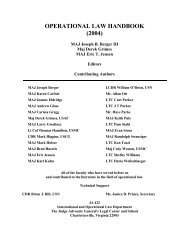Significant Incidents of Political Violence Against Americans 1988
Significant Incidents of Political Violence Against Americans 1988
Significant Incidents of Political Violence Against Americans 1988
Create successful ePaper yourself
Turn your PDF publications into a flip-book with our unique Google optimized e-Paper software.
ookshelf in the USIS Center in Kwangju. The<br />
components <strong>of</strong> the device included a white plastic<br />
container, desk clock, nine-volt battery, and a<br />
chemical substance. The device failed to detonate.<br />
According to press accounts, a South Korean<br />
university student allegedly admitted to planting the<br />
device, which the student claims was provided to him<br />
by another person.<br />
March 18, <strong>1988</strong>--Seoul, South Korea: Five or six<br />
Korean youths hurled seven molotov cocktails onto<br />
the U.S. Far East Engineer military base and fled the<br />
scene. Only two <strong>of</strong> the seven molotov cocktails<br />
ignited, and the only damage resulting from the<br />
incident was a broken windowpane. The incident<br />
occurred in the aftermath <strong>of</strong> an anti-American and<br />
anti-Korean Government rally held earlier in the<br />
day at nearby Hanyang University. The attack was<br />
the first known instance <strong>of</strong> firebombs being hurled at<br />
a U.S. military base in South Korea.<br />
April 20, <strong>1988</strong>--Singapore, Singapore: A cleaning<br />
woman discovered a suspicious looking device<br />
wedged beneath a washbasin <strong>of</strong> a restroom in the<br />
U.S. Embassy Consular Section. After cordoning <strong>of</strong>f<br />
surrounding streets, the Singapore police bomb<br />
squad used a high-power water cannon to detonate<br />
the device outside the U.S. Embassy Chancery,<br />
which is located in the heart <strong>of</strong> the business district.<br />
The device, which appeared to be a pipe bomb,<br />
contained a 6-inch long pipe, batteries connected by a<br />
short wire, and black powder wrapped in yellow<br />
masking tape. No group has claimed responsibility<br />
for planting the device.<br />
May and June <strong>1988</strong>---Pampanga and Angeles<br />
City, Philippines: During the period from May to<br />
June <strong>1988</strong>, two Pepsi-Cola trucks in Pampanga and<br />
three Coca-Cola trucks in the Angeles City environs<br />
were seized and set afire. The modus operandi <strong>of</strong> the'<br />
seizures was similar in every case. After apparently<br />
following the truck for some time, the hijackers<br />
approached the driver after he stopped the truck to<br />
make a delivery. The hijackers then identified<br />
themselves to the driver and ordered him to drive the<br />
truck to some remote location. Upon arrival at the<br />
remote location, the passengers (the driver and one<br />
or more company personnel) <strong>of</strong> the truck were freed<br />
unharmed and told that the truck and its cargo had<br />
been seized for nonpayment <strong>of</strong> taxes. The trucks<br />
were then set aflame.<br />
May 19, <strong>1988</strong>--Seoul, South Korea: An estimated<br />
1,000 Korean students armed with molotov cocktails<br />
and stones attacked the USIS building. The students<br />
burned a mock American flag, shattered windows<br />
with rocks, and tore a plaque representing the<br />
American eagle from the wails <strong>of</strong> the building. Riot<br />
police in armored cars dispersed the crowd with<br />
volleys <strong>of</strong> tear gas. There were no injuries or<br />
arrests. The attackers had been among 10,000<br />
students who marched on the city center as part <strong>of</strong> a<br />
funeral cortege for Cho Song Man, a Korean student<br />
from Seoul National University who 4 days earlier<br />
had committed suicide by disemboweling himself<br />
and then jumping <strong>of</strong>f the ro<strong>of</strong> <strong>of</strong> a four-story building<br />
on the grounds <strong>of</strong> Myongdong Cathedral in Seoul.<br />
Cho left a statement calling for the withdrawal <strong>of</strong><br />
U.S. forces from Korea, for joint hosting <strong>of</strong> the <strong>1988</strong><br />
Seoul Olympic Games, and for reunification <strong>of</strong><br />
North and South Korea.<br />
May 20, <strong>1988</strong>--Seoul, South Korea: At<br />
11:30 a.m., a number <strong>of</strong> young Koreans rushed the<br />
outside wall <strong>of</strong> the U.S. Embassy compound and<br />
threw loud explosive devices toward the Chancery.<br />
One device is believed to have exploded prematurely<br />
in the hands <strong>of</strong>one <strong>of</strong> the perpetrators. At least one<br />
<strong>of</strong> the other devices exploded on U.S. Embassy<br />
grounds, after which five <strong>of</strong> the assailants gained<br />
access to the Embassy grounds by scaling the front<br />
fence. The intruders then attempted to burn an<br />
American flag and to hang an anti-US, banner. In<br />
accordance with standard procedure agreed upon<br />
with Korean authorities, Korean police immediately<br />
entered the Embassy compound to remove the<br />
intruders. The intruders, armed with additional<br />
explosive devices and steel clubs, resisted the police<br />
but were apprehended within 5 minutes. Two<br />
additional persons were also apprehended in connection<br />
with the incident. No Embassy personnel were<br />
injured, and the building was not damaged.<br />
On November 14, <strong>1988</strong>, a Seoul court convicted<br />
Park Yong Ik and two others for the assault<br />
on the U.S. Embassy. The three attackers, who<br />
refused to participate in the trial, received 1-year<br />
prison sentences. After the judge left the courtroom,<br />
10 <strong>of</strong> the spectators began to demonstrate. The<br />
protestors were then joined by 30 others shouting<br />
anti-US, slogans and calling for the arrest <strong>of</strong> former<br />
President Chun Doo Hwan. After about 30-minutes,<br />
riot police moved in to restore order, detaining seven<br />
<strong>of</strong> the demonstrators in the process.<br />
May 23, <strong>1988</strong>---Kwangju, South Korea: During<br />
the afternoon, approximately 15 Korean males<br />
attacked the ACC with 10 molotov cocktails, 7 <strong>of</strong><br />
which ignited. Two <strong>of</strong> the males carrying molotov<br />
cocktails made their way to the ro<strong>of</strong> <strong>of</strong> the Center<br />
from an adjacent building, but were subsequently<br />
apprehended by police. There were no injuries to<br />
Korean or U.S. staff at the Center. However, some<br />
22
















